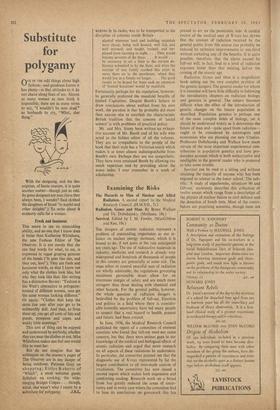Examining the Risks
The Hazards to Man of Nuclear and Allied Radiation. A second report to the Medical Research ,Council. ,(H,M.S.O., 7s.) Radiation, Genes and Man. By Bruce Wallace and Kee, 18s.)
THE dangers of atomic radiation represent a problem of outstanding importance as our re- liance on nuclear energy increases, which it is bound to do, if not quite at the rate anticipated ten years ago. The use of radioactive materials in industry, medicine and research is already very widespread and hundreds of thousands of people in this country are potentially at some risk. The steps taken to control peaceful uses of radiation are wholly admirable; the regulations governing maximum permissible doses allow for an enormous margin of safety and are much more stringent than those dealing with chemical and other hazards. For the general public, however, the whole question of radiation dangers is bedevilled by the problem of fall-out. Emotion and politics in a field where there is consider- able scientific uncertainty have led many people to suspect that a real hazard to health, present and future, had been created.
In June, 1956, the Medical Research Council published the report of a committee of eminent scientists who found that fall-out need not cause concern, but that there were serious gaps in our knowledge of the medical and biological effects of atomic radiation and urged that more research on all aspects of these radiations be undertaken. In particular, the committee pointed out that the diagnostic use of X-rays represented by far the largest contribution to all man-made sources of irradiation. The committee has now issued a second report which makes both impressive and comforting reading. Research work on a broad front has greatly reduced the areas of uncer- tainty and in every case where the committee had to base its conclusions on guesswork this has
proved to err on the pessimistic side. A careful review of the medical uses of X-rays has shown that the amount of radiation received by the general public from this source can probably be reduced by technical improvements to one-third without curtailing any of the benefits. It is quite possible, therefore, that the alarm caused by fall-out will, in fact, lead to a level of radiation exposure lower than that existing before the coming of the atomic age.
Radiation, Genes and Man is a magnificent book setting out the very complex problem of the genetic dangers. The general reader for whom it is intended will have little difficulty in following the introductory chapters on radiation biology and genetics in general. The subject becomes difficult when the effect of the introduction of genetic changes on the future population is described. Population genetics is perhaps one of the most complex fields of biology, yet it should be understood widely as it determines the future of man and—quite apart from radiation— ought to be considered by sociologists and economists who are planning our new Utopias. Professors Dobzhansky and Wallace have made certain of the most important experimental con- tributions in population genetics and have pro- ducedan account which is both authoritative and intelligible to the general reader who is prepared to take some trouble.
Survival can be read at a sitting and without straining the capacity of anyone who has been exposed to science in the lower school. The sub title, 'A study of superbombs, strontium 90 and fall-out,' accurately describes this collection of twelve essays which range from a descriptipn of the physics of nuclear fission to civil defence and the detection of bomb tests. Most of the contri- butors are practising scientists, though none are of the eminence of the authors of Radiation, Genes and Man.
All these publications illustrate the great attention that is paid to the risks from small doses of atomic radiations.. What is less well known is that there are many chemicals which produce exactly comparable biological effects, including genetic damage only seen in future generations, as well as delayed effects such as cancer and leukxmia many years after exposure. In the modern environment, man is continually being exposed to such chemicals in the atmosphere and in food, as well as occupationally in factories and workshops. While sonic steps are at last being taken to guard against the introduc- tion of cancer-producing substances, the genetic dangers from chemicals have been completely neglected. It is to be hoped that the strict criteria universally accepted with regard to radiations will, in the not too distant future, be extended to
pollution by chemicals.
PETER ALEXANDER











































 Previous page
Previous page